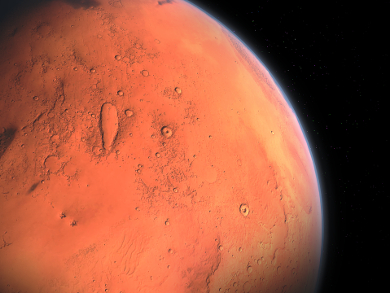The Mars rover “Curiosity” has detected organic molecules in four places in the Gale Crater of Mars. Among them are sulfur compounds such as thiophenes and dimethyl sulfides, but also aromatic compounds such as toluene, chlorobenzene, and naphthalene, as well as chain hydrocarbons, as reported by Jennifer L. Eigenbrode, NASA Goddard Space Flight Center, Greenbelt, MD, USA, and colleagues.
So far, planetary researchers have searched for organic compounds in vain. Mars Rovers detected small amounts of chlormethane, but it remained unclear whether this compound actually came from the Martian rock or was contaminated by the analyzers. The concentration of the now detected organic compounds in the samples was in the range of 10 ppm and more. That is one hundred times larger than what previously has been detected.
The Gale Crater is a depression that was most likely a freshwater lake about 3.5 billion years ago, with life-friendly conditions. The samples were heated in the oven of the rover to more than 600 °C and the released vapors were then analyzed by a mass spectrometer and a gas chromatograph. The molecules that were found could be fragments of larger, more complex compounds that have decayed during analysis.
Where the molecules come from—whether they are of biological or non-biological origin—is still unclear. They are not necessarily evidence of past or present life on Mars, but instead, may have been created by abiotic processes or brought to Mars by meteorites.
The samples examined by Curiosity come from the top 5 cm of the Martian surface and thus from a chemically very aggressive and hostile environment. The Martian surface is exposed to cosmic rays and the ionizing and oxidizing conditions are extreme. For a long time, researchers had suspected that organic matter could not survive there. Presumably, the high sulfur content prevented many of these compounds from decaying. It may be possible to find better-preserved molecules deeper below the surface, where the effect of radiation is lower.
- Organic matter preserved in 3-billion-year-old mudstones at Gale crater, Mars,
Jennifer L. Eigenbrode, Roger E. Summons, Andrew Steele, Caroline Freissinet, Maëva Millan, Rafael Navarro-González, Brad Sutter, Amy C. McAdam, Heather B. Franz, Daniel P. Glavin, Paul D. Archer, Paul R. Mahaffy, Pamela G. Conrad, Joel A. Hurowitz, John P. Grotzinger, Sanjeev Gupta, Doug W. Ming, Dawn Y. Sumner, Cyril Szopa, Charles Malespin, Arnaud Buch, Patrice Coll,
Science 2018, 360, 1096–1101.
https://doi.org/10.1126/science.aas9185




